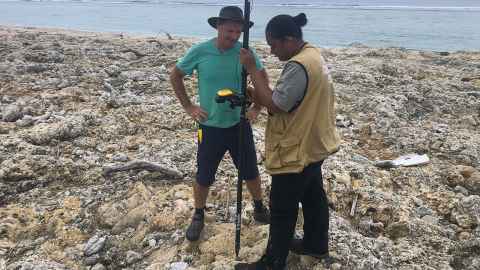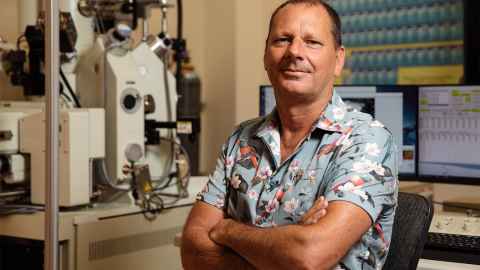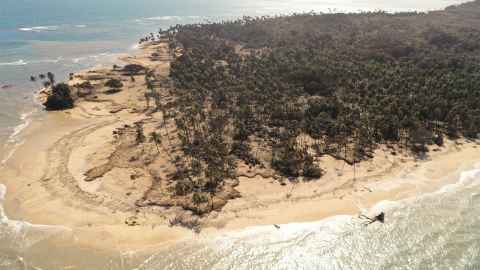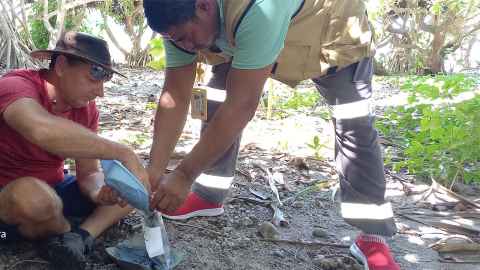Shane Cronin: Tonga's call to adventure scientist
16 May 2022
Professor Shane Cronin was the first overseas volcanologist to be allowed in to Tonga after the January 2022 eruption.

Volcanologist Shane Cronin first walked this earth in the area known as the Taupō Volcanic Zone.
Yet despite the proximity of his home town to the geothermal wonderland of Rotorua and the active Tongariro, Ruapehu and Ngauruhoe volcanoes, engineering was the University of Auckland Professor of Volcanology’s early calling.
But the pull to study earth sciences soon trumped engineering. That change of direction became significant this year with the vast eruption, on 15 January, of Hunga Tonga-Hunga Haʻapai, a volcanic island 65km north of Tongatapu, Tonga’s main island.
The event not only sent shockwaves around the world – it was heard in Alaska and, helped by Cyclone Cody, its tsunami sank several boats at Tutukaka marina in the Bay of Islands – but also propelled Shane to prominence through scores of interviews with international media.
“I’m sometimes getting hassled by my students and colleagues about being a celebrity volcanologist, but I haven’t had any bad responses yet,” he says.
Shane is unsure whether his ultimate career choice can be attributed to his Taupō upbringing.
“Where I grew up was right on the east of the big volcano and I was very familiar with Tongariro, Ruapehu and Ngauruhoe – we did all the school trips to those volcanoes. I recall my parents talking about the threat of eruptions because there was unrest in the 1980s at Taupō.
“But when I went to uni, I was intending to do engineering. Then I was tempted by chemistry, which I did for a little while until I realised I was going to be stuck in a lab.”

I am helping co-ordinate the science response as well as being a point-person for New Zealand and international teams that want perishable information to improve tsunami and ash-fall models.
His taste for outside work had developed while doing horticulture jobs to help pay for his studies.
“What drew me to geology was the potential for a young fellow from central New Zealand to travel to far-flung locations and the chance to work outdoors. Earth science is in many ways the adventure science.”
Speaking to Ingenio from Tonga, where he was the first overseas volcanologist to visit after the eruption, Shane is happy with the way his career is playing out.
“I definitely made the right choice. I’m one of the few overseas scientists Tonga let through the door early, and I am helping co-ordinate the science response as well as being a point-person for New Zealand and international teams that want perishable information to improve tsunami and ash-fall models.”
He says it’s important to collect the ash samples early as they can get washed away. He has been running training days in the field with staff from Tonga Geological Services, covering survey techniques and deposit interpreting.
Shane did his undergraduate and PhD degrees at Massey University, graduating in earth sciences. His doctoral thesis was a study of volcanic and glacial deposits in the Tongariro River catchment that teased out the relationship between climatic change and volcanic activity.
“The way volcanoes erupt depends on such things as how much surface water there is and whether there is ice on top of the volcanoes.”
He says both are important in shaping the hazards of New Zealand volcanoes.
“When there are big ice fields and lots of snow, we get a lot of lahars.”

What drew me to geology was the potential for a young fellow from central New Zealand to travel to far-flung locations and work outdoors. Earth science is in many ways the adventure science.
Even in the absence of an eruption, lahars can be lethal. In the 1953 Tangiwai disaster, a flash-flood of rock and ice from Mt Ruapehu’s crater lake undermined a rail bridge, causing a derailment that killed 151 passengers on the Wellington to Auckland night express.
Shane’s career changed direction when Mt Ruapehu erupted as his PhD was close to completion in 1995. Instead of geo-hydrology, which had been his interest, his focus moved to active volcanoes.
This has led to work in several Pacific nations over the past 25 years, including three years in Fiji, and so many trips to Tonga that he forgets whether his present visit is his seventh or eighth.
Pure science represents less than half of the work he does in the field.
“In Tonga, the small team is getting information requests from Health, Agriculture, the Tonga Meteorological Service and other branches of government about the January eruption. We’re collecting information that’s applicable to ongoing scientific studies and also for future planning, such as where to relocate villages and how to better foresee and respond to the next event.”
Shane and the team even managed to snorkel close to the Hunga volcano in April, discovering that what used to be an island is now 200m deep.

Closer to home, Shane is also co-lead on a research project until 2024, ‘Transitioning Taranaki to a Volcanic Future’, through the MBIE Endeavour Fund. It will look at what would happen if an eruption started and didn’t stop in the Taranaki region.
“The science is great as an academic exercise, but providing hazard assessments and impact studies that can be used to manage public safety, for instance, is far more satisfying than simply publishing a paper in a good journal.
“What I like about being at the University is that you get to do both.”
Story by Anthony Doesburg for Ingenio magazine, Autumn 2022.
Email: ingenio@auckland.ac.nz
See Stuff story for Shane snorkelling over the volcano site.